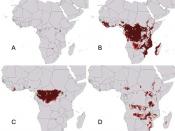Ebola hemorrahagic fever is a 20 year old virus that, with a mortality rate of 50% to 90%, is one of the world's deadliest viruses. Its causative organism is called Ebola virus. Ebola virus is a member of filoviridae, a family of negative-strained RNA viruses. The filoviridae family consists of five known members, Marburg, Ebola Zaire, Ebola Sudan, Ebola Reston, and Ebola Tai.
Ebola virus is spread in a number of ways. An outbreak starts when an infected animal or insect, called a vector, transmits the virus to a human. Scientists know that monkeys are both a vector and victim of Ebola, but other vectors are unknown. The natural reservoir for the virus, or organism that is immune to it and carries it is also unknown. A search for the reservoir will take a long time because there are so many possibilities, since Africa is in the tropics. Another way that humans can get Ebola is by eating an infected animal or drinking the milk of an infected animal.
Ebola is spread from human to human by contact with infected blood, infected body fluids, or through sexual contact. Even after a person recovers completely from Ebola, it may stay in the semen for up to seven weeks. In the African outbreaks it has also been transmitted by the reuse of needles because the health care systems are so under financed. Ebola wasn't thought to be an airborne virus, but recent studies by the US Army Medical Research Institute of Infectious Diseases and the CDC found that monkeys showed Ebola like symptoms after being exposed to aerosolized Ebola. The studies also found that the virus is many times present in the respiratory systems of Ebola victims. Although the 1989 outbreak in Reston, Virginia wasn't harmful to humans, it was found...


